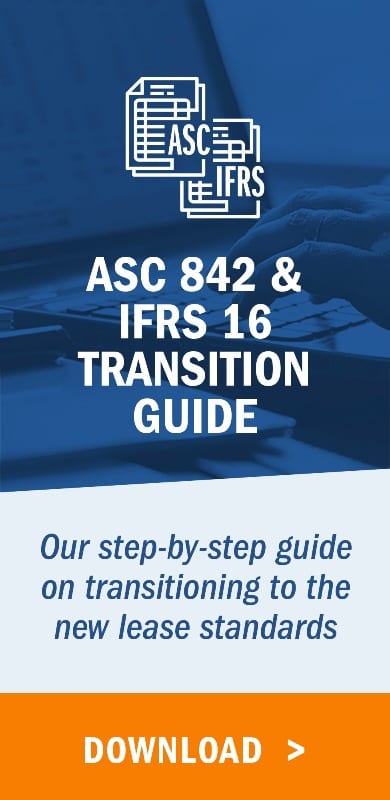The ASC 842 deadline is rapidly approaching. Private companies and not-for-profit entities adopting the new standard need to prepare for a demanding transition process as they work to achieve compliance.
FASB’s new standard brings new accounting challenges to nonpublic entities. This article is designed to help guide private companies as they navigate through the transition and unlock financial insights on their journey to compliance.
Are you prepared?
As you implement ASC 842 at your company, you will face unforeseen issues that will prolong the adoption process. Properly preparing for the transition will help you navigate through these challenges more effectively.
First and foremost, it’s imperative you record all of your leases correctly, including identifying embedded leases. To ensure you have plenty of time to undergo the process, you need to start gathering all appropriate lease data now.
The following questions will likely arise during your preparation process:
- Does the entity keep a complete listing of all vehicles, copiers, or other equipment under master lease agreements, including various start and end dates?
- Has the company researched embedded leases and assessed service contracts for embedded lease assets?
- Has your organization assessed its capitalization threshold to scope out low-value leases?
Answering these questions now will help lead to a smooth transition, whenever you choose to begin.
What are the keys to a successful transition?
- People – people from all departments should be included in your transition plan to ensure a complete lease inventory
- Tools – investing in a lease accounting solution will expedite the transition process and help organize all of your data.
- Processes – creating clear, easy-to-follow processes for recording leases and updating your procedures around incoming leases will make certain you don’t miss any leases.
Understanding your lease portfolio
Many people assume the first step to transitioning is to compile all of your leases into a list, but that can be an inefficient use of resources, particularly if some of your leases are immaterial. Materiality is different for each company, so some steps can be taken before listing your leases to establish a threshold and decrease your workload.
Before creating an inventory of your leases, seek immaterial leases for further analysis. Your company may establish a lease capitalization threshold, similar to an asset capitalization threshold, which will help the business reduce the amount of low-dollar assets below the threshold.
Companies can lease a variety of low-dollar-value equipment. Your organization needs to discuss a proposed threshold with your auditors to avoid a significant amount of additional effort at year-end to capitalize the originally scoped-out leases. Write a memo documenting the reasoning and ensure you have a buy-in from your external auditors.
Identify a point person to head the transition
Coordination is key to your compliance. Your organization should choose a person to lead the transition so it proceeds smoothly. This person will communicate with stakeholders from numerous departments and help select an appropriate lease accounting solution to assist with the implementation process.
Choose a point person in each department
A cross-functional team is critical to the success of the adoption process. Choose a point person in each of the departments listed below as well, to work on the transition project:
- Legal
- IT
- Accounts payable
- Financial planning and analysis
- Fleet
- Real estate
- Financial reporting
- Purchasing/supply chain
- Treasury
Each point person is responsible for attending meetings, providing contracts, and various other transition tasks. The selected transition team should create a list of all leases and leased assets within each department, location, and/or entity. The lease accounting software you choose will likely benefit every point person on the project. You can create access and restrictions for each person depending on their role.
Select lease accounting software
The lease accounting software your company uses is critical to your transition. Picking your accounting solution months before the transition deadline will give you more time to implement your software, train your teams, and learn which features will help you successfully transition to the new lease accounting standards. You will likely unlock other software benefits to help your business long after compliance as well.
Benefits of lease accounting software
Lease accounting software provides many benefits beyond compliance. Organizations that have already transitioned will tell you that the right lease accounting application empowers organizations to:
- Make informed financial decisions
- Stay on top of lease renewals and other contractual deadlines
- Spend less time stressing on the actual adoption date
- Complete easier and more efficient audits
- Communicate better between departments
- Implement and automate effective internal controls
Compile all lease and leased asset data
Each department should list all assets they lease, including the lease start date, lease end date, and payment terms. For some departments, such as real estate, purchasing/supply chain, and information technology, distinct steps can be followed to ensure a complete listing. Be sure to check this transition guide to find the specific rules for each department.
Identify all offices, warehouses, an/or commercial locations, including owned properties
Identify all of the locations you need to collect lease data from. For a more efficient process, choose a point person at each office, warehouse, and commercial location to ensure each physical asset is recorded.
The easiest way to conduct this is to send a template for the point person at each location to complete. This template should include:
- Asset type
- Internal identification information
- Lease start date
- Asset possession date
- Lease end date
- Payment terms
Reconcile data and create a lease inventory
The point person overseeing the transition should consolidate the data gathered from each source and double-check for duplicates. During the reconciliation step, the focus should be on comparing the lease data from the department and locations and ensuring accuracy. Match the lease identification information—location, asset serial number, contract, vendor data, etc.—for each lease to the physical assets from each location. Then match the lease assets to the correct lease agreements and ensure there are no duplicates.
Once you have identified duplicates and correctly matched leased assets to lease contracts, you should validate the completeness of the listing.
Validate completeness using the lease commitment schedule
The next step is gathering the details of the five-year lease commitment schedule in the notes to your financial statements from the financial reporting department. To obtain this, check the supporting documentation for your most recent annual report.
The point person should compare the lease commitments schedule to your newly compiled lease inventory listing and make sure all of the previously reported lease commitments are included in the listing of lease data.
Get the details of rent expense for the most recently completed year-end
You need to gather the details of total rent expense from your most recent annual income statement or statement of activities. Your AP department can give you a listing of recurring payments in your various rent accounts. Compare these recurring payments with the lease agreements you compiled as another check your lease inventory is complete.
Perform a reasonableness test for rent expense
After you gather the lease inventory, extrapolate your expected annual rent expense using the payment terms for each lease. Then, perform a reasonableness test by comparing your estimated annual rent expense to the total rent expense from the general ledger. The amounts should be materially consistent. Understanding any significant variances will help you determine if your lease inventory is correct.
If your extrapolated annual rent expense is significantly less than your actual rent expense, your lease inventory listing is incomplete. On the other hand, if the actual annual rent expense is significantly less than this extrapolated annual lease expense, other general ledger accounts where rent expense is recorded may exist. This could happen if you identify embedded leases throughout the lease inventory process not included in a rent expense account.
Make any necessary adjustments to your lease inventory listing
After you finish all these steps, your company’s lease inventory should be complete. The best way to comply with ASC 842 is to input this complete listing into a lease accounting software. The system will then calculate the appropriate transition journal entries and ensure you have a smooth transition.
Summary
Private companies need to ensure they take the right steps throughout the transition process. Following all the steps listed above will help you feel more confident throughout your ASC 842 compliance journey. The time you invest in the process will pay off in your day-to-day workload.
Accounting software like LeaseQuery will make the transition process easier and more efficient. Many accountants who already use lease accounting software have significantly decreased the time it takes to prepare journal entries and create reports.
LeaseQuery is here to help you organize your lease data and recover from any hiccups you encounter on your transition journey. Check out our ASC 842 checklist for more tips on easing the adoption process and download a more detailed version of our ASC 842 Transition Guide here.





